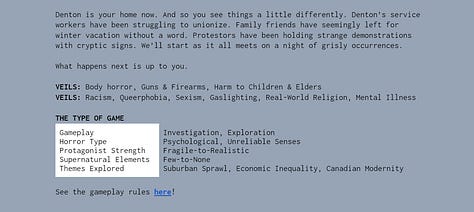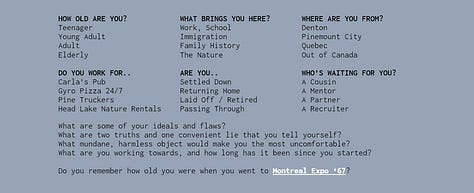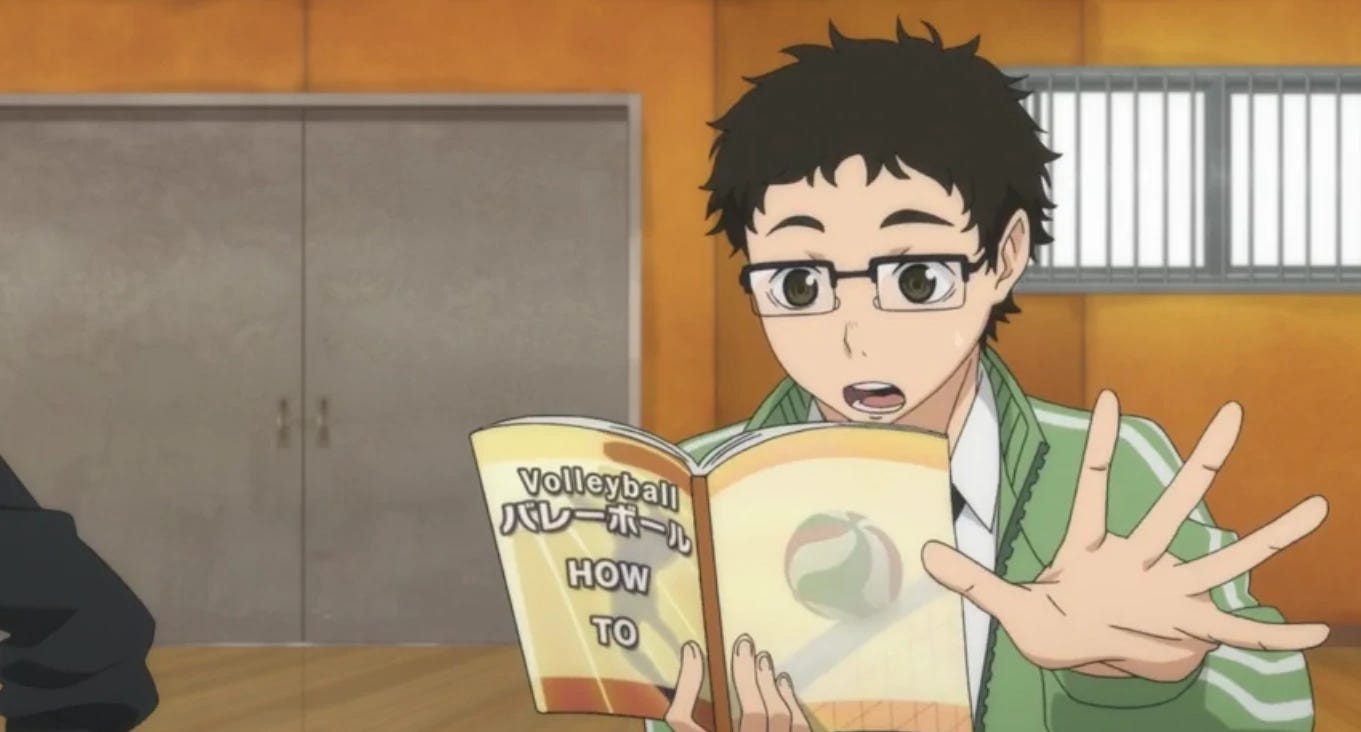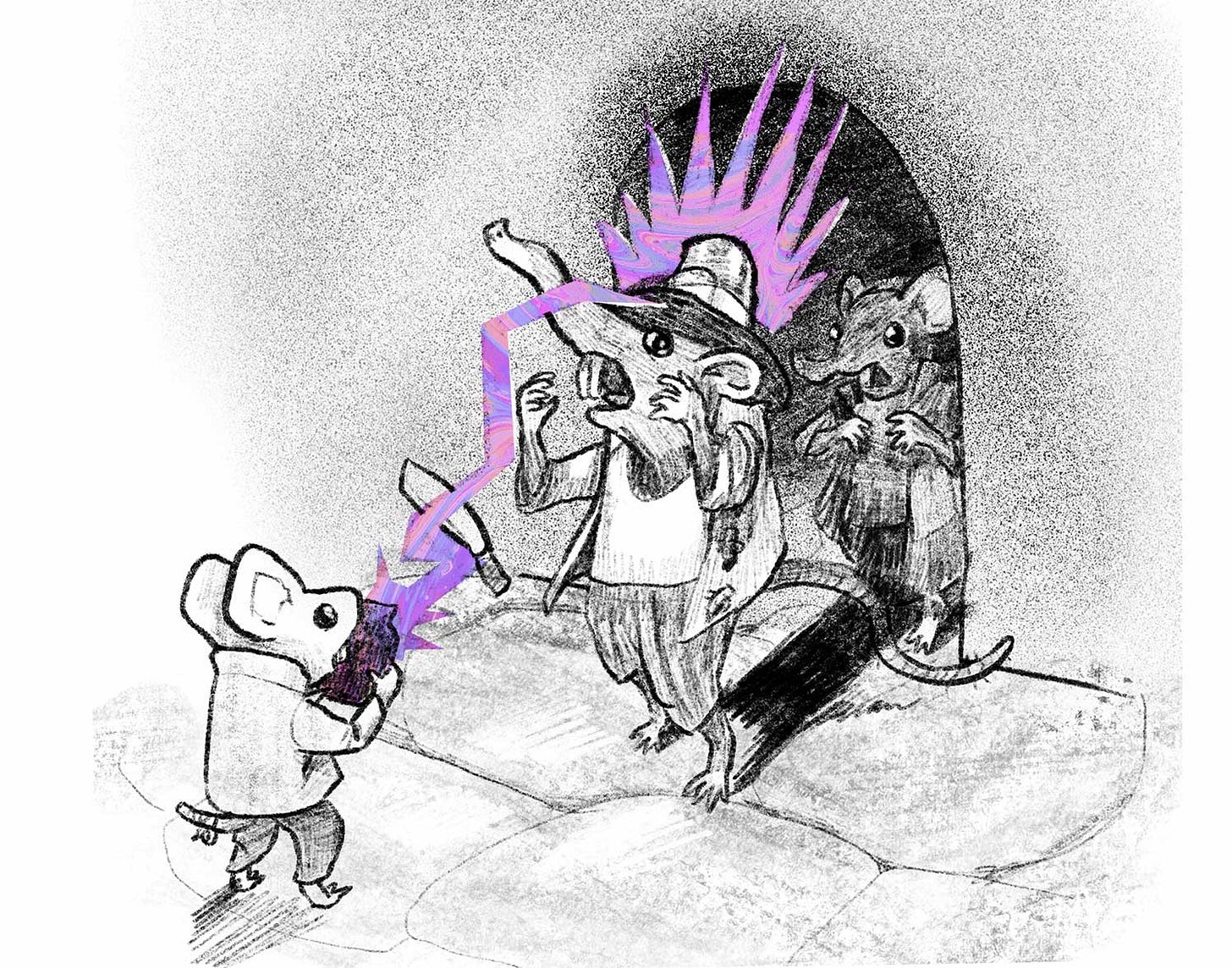intro
I love tabletop roleplaying games (TTRPGs) and I think you might too! This is part of a series on how to get started. It’ll include checklists, advice, and ready-to-print resources so you can hit the ground rolling.
INGREDIENTS
. friends
. snacks
. the audacity
EQUIPMENT
. six-sided dice
. pencils
. index cards
. google docs
. other boardgame piecesRESOURCES MENTIONED
. Support Tools (google drive)
. Lines/Veils (blog + form template)
. X-Card (print cards + original)
. Same Page Tool (blog)first times
To cover all our bases1— in a roleplaying game, PLAYERS create a story together. Games usually have rules and prompts that guide your story. PLAYERS usually play a single character in the story, although some games have rotating casts.
Many games have a GM (“GAME MASTER”) player. The GM tends to play the world, reacting to player decisions to show consequences and how non-player characters react.
So a GAME MASTER might describe a bar the PLAYERS enter, a PLAYER might punch a patron, and then the GAME MASTER might describe how another patron tackles them.
The GAME MASTER also judges if something a player wants to do is even possible, and then what the consequences are based on the game’s rules. Some games don’t have a GAME MASTER, and instead provide rules and prompts for all players to split up the role2.
types of games
Because the GM usually knows the game best, they usually organize the night.
But even if you don’t have a GM, you’re likely taking on similar roles outside of the game3. You might start with a group of friends and craft a game around them. Or you’ll pick a game and craft a group of friends who are excited for it. It’s like how you’d organize a movie night!
If it’s your first time, it’s likely your players’ first time too, so a classic Dungeons & Dragons campaign can be a huge investment. I find it more fun to start smaller.
I think these three are the easiest to set up—
ONESHOT: One night, one story. Less prep for everyone. The GM can prepare a smaller world and players don't commit to a longer story.
PARTY NIGHT: One night, many minigames. Almost no prep and you cycle through very short, rules-light games. Great for players who haven't roleplayed before.
MAIL GAME: One Google doc or email thread. Players take turns writing when they can (weekly is a good rhythm). Great for players who like worldbuilding.If you choose a ONESHOT or PARTY NIGHT, I like sharing a “hub” Google Doc with every piece of information. A groupchat can help too, but information about the game, time/place, and tone can get lost in messages. Having a “GM” doc with extra music, hidden plot details, and your schemes can help too.
If you choose a MAIL GAME, I like sharing a Google doc with links to the game rules and mood music on the first page. Creating and resolving comments is an unintrusive way to notify other players that you’re passing the pen to them. Emails solve the notification issue, but don’t let you play with fonts/links/immersion in the same way.



crafting a game
After choosing a game, players have a lot of flexibility in how they’ll use it. I like to think of each TTRPG as a toolbox of story prompts and suggested mechanics to help simulate those stories4.
So it helps to communicate what kind of game you hope to run, what boundaries you have about content, and learn what kind of play your friends enjoy.
Most importantly, what kind of fun are you and your friends looking for? If you’re not quite sure, talking through the Same Page Tool5 can help too. And remember that your fun as a likely GM also matters!
Here’s my bastardized take on the The Angry GM’s notes—
FANTASY: We want to escape into another world/story/character. Give us immersion and suspend our disbelief.
NARRATIVE: We want to play through a dramatic, well-done story. A pre-made setting and familiar genre can help.
CHALLENGE: We want to "win" against obstacles and foes. Give us combat, well-defined rules, and hard consequences.
FELLOWSHIP: We want to spend time with each other. Give us ways to cooperate, interact with each other, and contribute.
DISCOVERY: We want to explore and learn about the world/our characters. Give us secrets, mystery, and details to dig up.
EXPRESSION: We want to express ourselves through this. Give us a mic, ways to act on our beliefs, and ways to shape the story.Since stories are improvised, SAFETY TOOLS help us stay comfortable and check in on each other. For example, if the GAME MASTER wants to include a potentially triggering scene, tools like LINE/VEILS can help players rule that out before a game. Tools like the X-Card can help us pause and adjust mid-play.
Talk to your friends about setting hard boundaries before the game, and how you can check-in/enforce those boundaries as you play. There’s a lot of resources/discussions around safety and consent in TTRPGS, so I’ll do another blog on that soon!
prepping for game night
While games like Warhammer 40k are infamously expensive, I think TTRPGs can be incredibly affordable. You can buy PDFs instead of physical books, and there’s countless of pay-what-you-can indie games to experiment with.
Many games use dice with unconventional sides — but buying a d4, d6, d8, d10, d12, d20, and d100 can be pricey. I still haven’t, so I pick games with six-sided dice (d6), no dice, or modify their rules.
I think you can also do a lot with playing cards, coin flips, and using pieces/boards from other boardgames you might have around. Chess pieces make for great player/enemy minis, while colored tokens from games like Pandemic work great for tracking points.
If you have a laptop, you can refer to your GM doc (with story notes, lore, and rules). You can leave on some music mixes from channels like Blue Turtle, Cryo Chamber, and nobody.
This my checklist for game night—
Bring snacks and water (or ask a friend to be the snack captain)
Print a summarized copy of the game rules
Make X-Cards on index cards and go over your safety tools
Set chairs around a big table or clear a space on your floor to sit
games to try
The following games have very little prep for both GMs and players. They’re also pay-what-you-can!
(★) The Hands of Rasputin is incredibly short and simple. Worldbuilding happens naturally as players one-up each others’ assassination attempts. It’s my favorite to run with first time players!
The Goose of Grillner Grove is also short and simple. Players build out the stories of a village terrorized by a goose.
Bakto’s Terrifying Cuisine has a fully-fleshed out setting so you can step in without worldbuilding.
Together Among the Stars and Adrift in the Station Revenants are journaling games with detailed prompts. It’s a sci-fi story great for players who like writing.
Abnormal is an intimate horror game. One to three players rotate through roles of the character being transformed, people in their life trying to help, and the horror itself.
These games are great for more traditional campaigns, where the GM builds out a world for players to explore—
MORK BORG BAREBONES is a grimy, metal-inspired world. It feels like the DOOM 2016 soundtrack.
Wanderhome is a “pastoral fantasy” without any dice. It’s cozy and sweet!
Mausritter is also full of small animals, but has dice, more danger, and a darker tone.
outro
Perhaps more than most new hobbies, TTRPGs front-load a lot of information. I got hooked through shows like Dimension 20, which set an impossibly high bar with professional actors and production standards. But the magic and fun can happen at any level of play.
All it really takes is being a creative, kind person with some friends you want to spend an evening with! I was pretty nervous when I started though, so watching shows like Dimension 20 and their advice podcast Adventuring Academy helped me pass time until I organized a game night.
Personally, I love creating strange worlds and telling unpredictable stories in them with my friends. With the explosion of indie TTRPGs and actual-play shows, I’m sure there’s a TTRPG out there for you.
I hope you find one you like!
Terminology is fiddly and boring, but here’s some anyways!
GAME: A set of rules/prompts.
SESSION: An event where you play said game.
CAMPAIGN: A series of sessions that share a story.
SYSTEM: A broader set of rules/prompts that many games fit into (eg. Cairn).
HACK: A game/system that modifies another game/system (eg. Adding guns to Cairn).
SETTING: A setting for a story, usually made to be played with certain games/systems (eg. A feudal-Korean setting for Cairn).I wrote about some of them in shinies - belonging (v004), and why splitting up the GM role lets us tell more diverse stories!
It can be a lot of work! So if you know them well, your players might be willing to take on snack and scheduling duties as you craft the TTRPG.
On a spectrum of audience agency, boardgames with fixed mechanics but flexible stories sit between movies and TTRPGs!
I’m so happy I found this blog while researching this! Chris Chinn, aka Deeper In The Game / bankuei, has some great GM tools as well as great writing on diversity and racism within TTRPGS.


